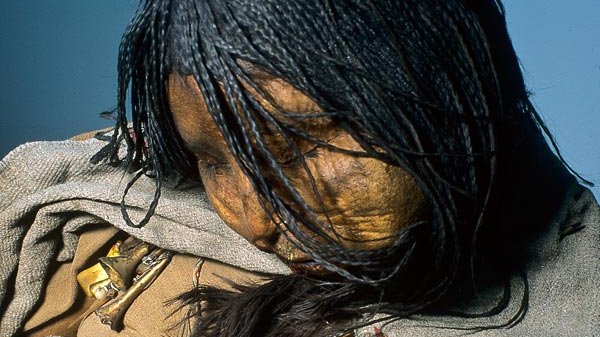The Llullaillaco Maiden was discovered on the summit of the Volcán Llullaillaco in Argentina in 1999. Recent tests revealed that this sacrificed Inca 13-year-old used coca at a high level during the last year of her life, but her alcohol use surged only in her last weeks. (Courtesy Johan Reinhard)
Ancient Incas may have sacrificed some of their young children, but at least they drugged them first.
Researchers were able to examine the hair of three 500-year-old mummies discovered at the summit of Volcán Llullaillaco in Argentina, revealing what they ate and drank in the last two years of their lives.
The hair of one mummy in particular -- an incredibly well-preserved 13-year-old girl, known as the Llullaillaco Maiden -- was subjected to biochemical analysis. As it turned out, the Maiden began to ingest not just food, but alcohol and coca in the months leading up to their sacrificial ceremony.
Inca religious ideology linked mind altering substances and their resulting altered states to the gods, but the drugs may have helped reconcile these children to their fates.
The Maiden, along with the mummies of two younger children, the Llullaillaco Boy and Lightning Girl, were discovered in 1999. Thanks to the extreme low temperatures at the nearly 7,000-meter summit of the volcano, they are extraordinarily well-preserved.
"I suppose that's what makes this all the more chilling," said Andrew Wilson, a forensic and archaeological expert at the University of Bradford in the U.K. "This isn't a desiccated mummy or a set of bones. This is a person; this is a child. And this data that we've generated in our studies is really pointing to some poignant messages about her final months and years."
The Maiden's hair is particularly suited to mining information about the short lives of these mummified children. Her long, braided hair, which would have grown about a centimeter a month and then remains unchanged, gave researchers an accurate snapshot of her diet.
Wilson said the markers in her hair showed her diet changed about a year before she died, meaning that's likely when she was chosen for sacrifice.
Her regular use of coca and alcohol, which were not widely available, marked her out as unusual.
"We suspect the Maiden was one of the acllas, or chosen women, selected around the time of puberty to live away from her familiar society under the guidance of priestesses," Wilson said.
Her diet improved to include foods that would have only been available to the elite, such as maize and animal protein. But only in the last six weeks or so did her alcohol consumption rise dramatically.
"We're probably talking about the last six to eight weeks, which show that very altered existence, that she's either compliant in taking this or is being made to ingest such a large quantity of alcohol," Wilson said. "Certainly in her final weeks she's again entering a different state, probably one in which these chemicals, the coca and the chicha alcohol, might be used in almost a controlling way in the final buildup to the culmination of this capacocha rite and her sacrifice."
Wilson and his team's research was published in the early edition of the July 29 publication of the Proceedings of the National Academy of Sciences journal.















